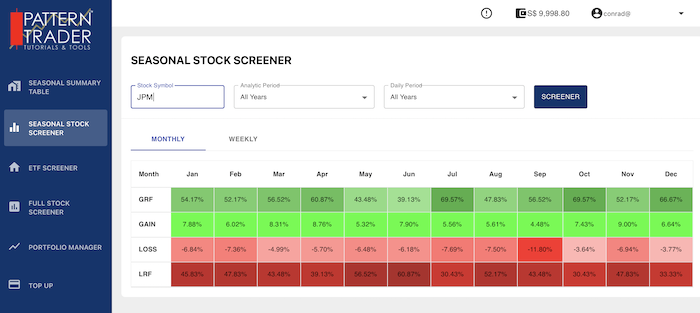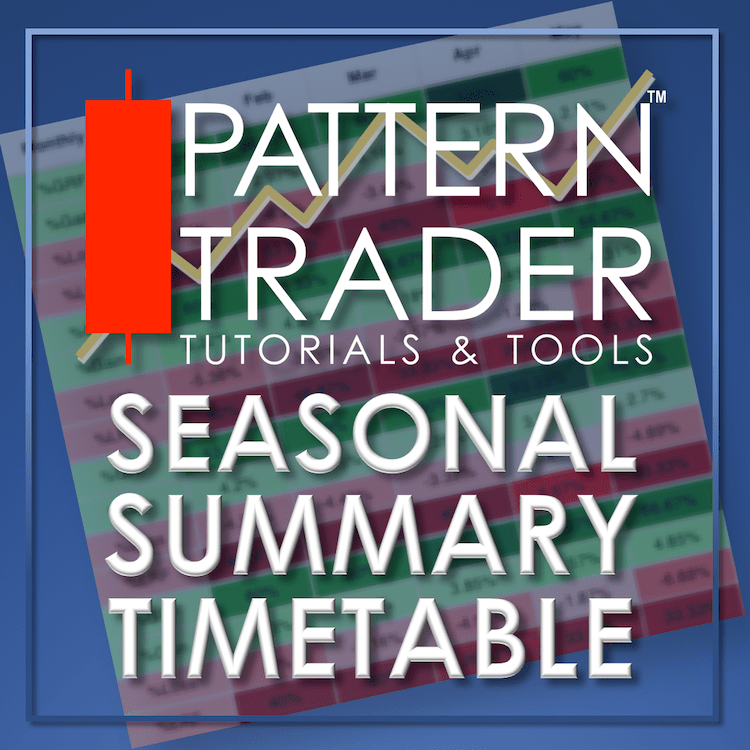The Seasonal Stock Screener is a free analytical tool, hosted at Pattern Trader™ Tools
The Seasonal Stock Screener gives the user the monthly and weekly reliability factors as well as monthly and weekly average returns (over specified periods of time) for stocks listed in the U.S. market. Screening is free-of-charge for all users and is limited to U.S. stocks only. (It will not screen Indices, ETFs, ETNs or similar portfolios/funds.)
It is necessary for the user to already know the ticker symbol of the security that they are screening for. For those not in the know, you may want to use this search function before starting your screen.

Each security will feature the monthly and weekly probabilities for bullishness (GRF) or bearishness (LRF) as well as the average percentage gains (Gain) or losses (Loss) over specific periods. (RF = Reliability Factor)
Analytical periods can be screened for 5, 10, 15 and 20 year averages for monthly and weekly factors.
The varying shades of colour are meant to emphasise the gravity of the RF – lighter implies that the factor is lower while darker implies that the factor is higher. Likewise, the darker shade on the Gain or Loss implies that the percentage gains or losses were greater on average.

For JP Morgan (JPM, Monthly – above), the month of April has been bullish 60% of the time (All Years) for an average +9.69% gain and bearish 40% of the time for an average -3.69% drop.
Having said that, February has the same RF statistics as April (60%/40%) but the drops during the 40% periods were higher at an average of -7.58% compared to the gains of +5.29%, 60% of the time.
How you choose to use this information is based on your personal risk appetite. It is obvious that April carries less risk in terms of the probability (RF) and return (%gain/loss) factor. February tends to pose a challenge if you happen to be in a year when it decides to go the other way for its 40% probability.
There is no “wrong or right” nor “better or worse” choice.
It’s all about risk and whether you choose to accept it or not.
Getting Started

- Key in your desired Ticker Symbol.
- Select the average numbers of years you wish to analyse using the Analytic Period (The “Daily Period” is disabled for this screener).
- Hit Screener.
- Choose your period of analysis from either MONTHLY or WEEKLY.
The weekly model will feature all the weeks of the year. Scroll to the right to see more.

Some Interesting Tid-Bits …
- Having a huge percentage RF may not be worth the risk if the average returns are below your risk appetite. In other words, would you take a risk if you had an RF of 80% if the average returns were +0.2% while the opposing 20% offers -9.9%?
- For the low risk takers, we strongly advise that you stick to high RFs with high average percentage returns. An RF of more than 70% is actually very good.
- For example, Week32 is perfect for the low-risk bull where the RF is high (78.26%) and the possible average percentage gain (+1.86%) is three-times the possible average percentage loss (-0.60%).

- For the bear, Week21 is really favourable at 63.64% RF for a possible average -2.10% return.
- Week27 for the bull may seem tempting at a massive 91.30% RF. However, you must consider that the possible average percentage drop 8.70% of the time is just about the same as its gain at 1.7% either way. The risk is yours to accept.
Terms & Conditions of Use
- The Free Stock Screener is free to use for everyone.
- Simply register an account at Pattern Trader™ Tools to login and start using the table.
- For a complete screen of stocks, it is recommended that you use the Full Stock Screener. The Full Stock Screener is a paid analytical tool. Each screen will cost $0.10¢ per ETF.
Join us at our Facebook discussion group: Pattern Trader™ Tools on Facebook
DISCLAIMER: The information contained herein is subject to change without notice and was obtained from sources believed to be reliable, but is not guaranteed as to accuracy or completeness. Those using the materials for trading purposes are responsible for their own actions. No guarantee is made that trading signals or methods of analysis will be profitable or will result in losses. It should not be assumed that performance would equal or exceed past results.



